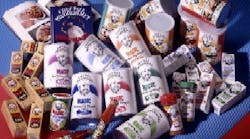| HUMBLE BEGINNINGS, NOBLE LEGACY Chef Paul Prudhomme, the first American-born chef to receive the coveted Merité Agricole of the French Republic, has eight cookbooks under his belt, including the now-classic "Chef Prudhomme's Louisiana Kitchen." He's hosted television shows, cooked for heads of state and at President Ronald Reagan's inauguration and has even been featured on A&E's "Biography." Born in a small rural community between Opelousas and Port Barre in Louisiana's Acadiana country, Prudhomme was the youngest of 13 children born to sharecroppers. The family had no electricity or refrigeration, so Prudhomme learned to appreciate a bounty of fresh and seasonal vegetables, fresh-caught crawfish from nearby streams and bayous, and freshly slaughtered chickens. Even more important, he learned to appreciate his family's love of cooking and eating together. "My food is simple in the sense it's what I grew up with, yet it has complexity," says Prudhomme of his cooking style. "I was very fortunate to grow up the way I did; I know what a chicken will taste like when it's in the yard, and whether it's been there six months or a year." Mother of invention Prudhomme first learned to cook helping his mother. "What my mother taught me is a reference point to what I'm doing today," he says. "I'd help her cook by stirring the pot and watch what was happening at each stage. She'd say, ‘We're making gumbo; I'm stirring flour in pork lard.' Then she'd show me how to do it. "How you stir the flour is very important, because as it changes color, the flavor changes. I can get 18 different colors out of flour," he continues. "That's how we make the different flavors. For gumbo, that roux is at the last stage. Just before it gets bitter, it gets real sweet. That's a mistake people have made with my recipes for years. They think I put sugar in it, but I don't. You can take just a little bit of flour that's almost over the edge, drop it in to get just a little bit of color and give it sweetness. It will give tomato sauce a great taste." Culture-bound "I remember distinctly the day I decided to salvage our cultural food," Prudhomme recalls. "I was visiting my parents, and my niece asked me to move my car so she could go to the store. Instead, I took her. She bought a base for dirty rice, one of our basic dishes. When I tasted it, I knew it had no relationship to what she could have made from scratch. It was on that trip, in 1970, I made the decision to (come back) and help make our food a ‘presence'." Prudhomme's mantra is "good cooking, good eating and good loving," and he truly believes it. "If you have young kids, they will never know who they are, they will never know who you are, and they'll never know where they came from unless you eat dinner with them two or three times a week," he says emphatically. K-Paul's Louisiana Kitchen started with and still serves cultural foods, including blackened fish, jambalaya and gumbo. He offers 15 kinds of gumbo in the restaurant. Although K-Paul's showcases Louisiana cultural foods, they use other cultural influences, for example sesame oil, to be creative. "You have to move on in some ways, but you have to stay true to the things that are important to you — like an okra gumbo," he explains. Prudhomme describes the real trend in food as constant evolution. "As food evolves, it becomes a mixture; then a part of the whole," he says. "Restaurant dishes might contain six to eight different cultures the original dish came from. It may not be exactly like the original ethnic dishes, but that's OK. American culinary is growing up; it still has a long way to go, but the majority of cooks are on board," he says. Prudhomme's Magic Seasoning Blends Inc. will be moving into a new 130,000-square-foot plant in September that will house offices, blending operations and R&D facilities. Also, look for Prudhomme's new TV show, "Louisiana Taste," coming to public television this fall. |

Latest from Home
Latest from Home

